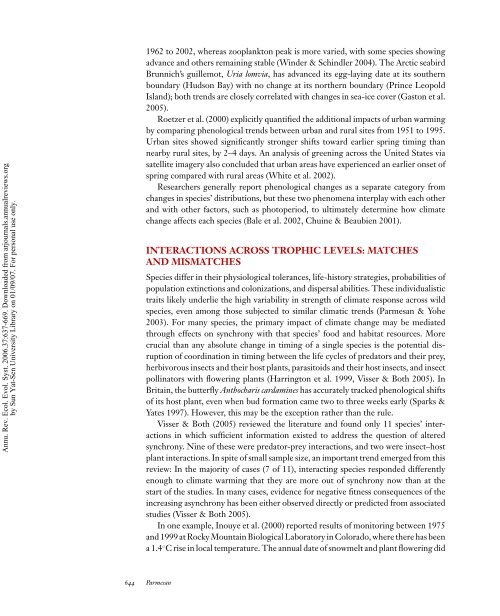Ecological and Evolutionary Responses to Recent Climate Change
Ecological and Evolutionary Responses to Recent Climate Change
Ecological and Evolutionary Responses to Recent Climate Change
Create successful ePaper yourself
Turn your PDF publications into a flip-book with our unique Google optimized e-Paper software.
Annu. Rev. Ecol. Evol. Syst. 2006.37:637-669. Downloaded from arjournals.annualreviews.org<br />
by Sun Yat-Sen University Library on 01/09/07. For personal use only.<br />
1962 <strong>to</strong> 2002, whereas zooplank<strong>to</strong>n peak is more varied, with some species showing<br />
advance <strong>and</strong> others remaining stable (Winder & Schindler 2004). The Arctic seabird<br />
Brunnich’s guillemot, Uria lomvia, has advanced its egg-laying date at its southern<br />
boundary (Hudson Bay) with no change at its northern boundary (Prince Leopold<br />
Isl<strong>and</strong>); both trends are closely correlated with changes in sea-ice cover (Gas<strong>to</strong>n et al.<br />
2005).<br />
Roetzer et al. (2000) explicitly quantified the additional impacts of urban warming<br />
by comparing phenological trends between urban <strong>and</strong> rural sites from 1951 <strong>to</strong> 1995.<br />
Urban sites showed significantly stronger shifts <strong>to</strong>ward earlier spring timing than<br />
nearby rural sites, by 2–4 days. An analysis of greening across the United States via<br />
satellite imagery also concluded that urban areas have experienced an earlier onset of<br />
spring compared with rural areas (White et al. 2002).<br />
Researchers generally report phenological changes as a separate category from<br />
changes in species’ distributions, but these two phenomena interplay with each other<br />
<strong>and</strong> with other fac<strong>to</strong>rs, such as pho<strong>to</strong>period, <strong>to</strong> ultimately determine how climate<br />
change affects each species (Bale et al. 2002, Chuine & Beaubien 2001).<br />
INTERACTIONS ACROSS TROPHIC LEVELS: MATCHES<br />
AND MISMATCHES<br />
Species differ in their physiological <strong>to</strong>lerances, life-his<strong>to</strong>ry strategies, probabilities of<br />
population extinctions <strong>and</strong> colonizations, <strong>and</strong> dispersal abilities. These individualistic<br />
traits likely underlie the high variability in strength of climate response across wild<br />
species, even among those subjected <strong>to</strong> similar climatic trends (Parmesan & Yohe<br />
2003). For many species, the primary impact of climate change may be mediated<br />
through effects on synchrony with that species’ food <strong>and</strong> habitat resources. More<br />
crucial than any absolute change in timing of a single species is the potential disruption<br />
of coordination in timing between the life cycles of preda<strong>to</strong>rs <strong>and</strong> their prey,<br />
herbivorous insects <strong>and</strong> their host plants, parasi<strong>to</strong>ids <strong>and</strong> their host insects, <strong>and</strong> insect<br />
pollina<strong>to</strong>rs with flowering plants (Harring<strong>to</strong>n et al. 1999, Visser & Both 2005). In<br />
Britain, the butterfly Anthocharis cardamines has accurately tracked phenological shifts<br />
of its host plant, even when bud formation came two <strong>to</strong> three weeks early (Sparks &<br />
Yates 1997). However, this may be the exception rather than the rule.<br />
Visser & Both (2005) reviewed the literature <strong>and</strong> found only 11 species’ interactions<br />
in which sufficient information existed <strong>to</strong> address the question of altered<br />
synchrony. Nine of these were preda<strong>to</strong>r-prey interactions, <strong>and</strong> two were insect–host<br />
plant interactions. In spite of small sample size, an important trend emerged from this<br />
review: In the majority of cases (7 of 11), interacting species responded differently<br />
enough <strong>to</strong> climate warming that they are more out of synchrony now than at the<br />
start of the studies. In many cases, evidence for negative fitness consequences of the<br />
increasing asynchrony has been either observed directly or predicted from associated<br />
studies (Visser & Both 2005).<br />
In one example, Inouye et al. (2000) reported results of moni<strong>to</strong>ring between 1975<br />
<strong>and</strong> 1999 at Rocky Mountain Biological Labora<strong>to</strong>ry in Colorado, where there has been<br />
a 1.4 ◦ C rise in local temperature. The annual date of snowmelt <strong>and</strong> plant flowering did<br />
644 Parmesan
















